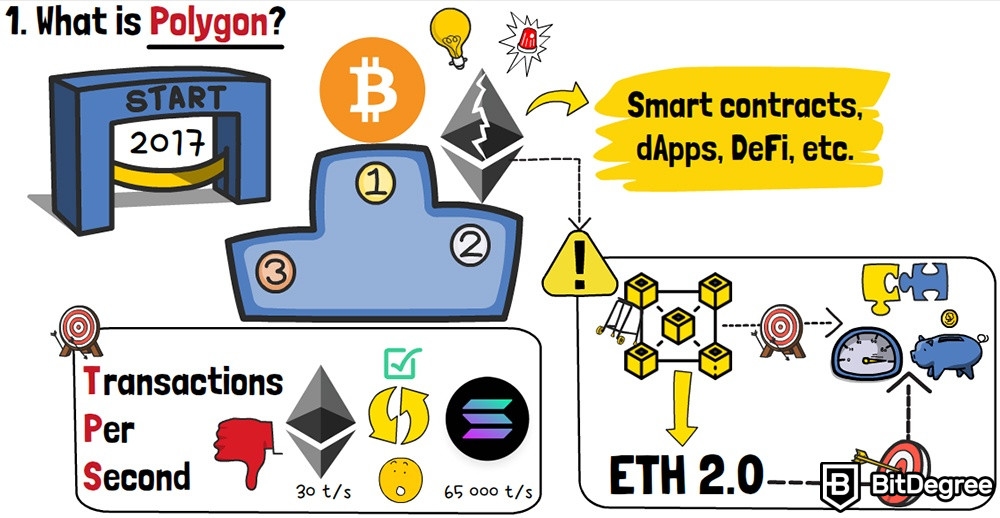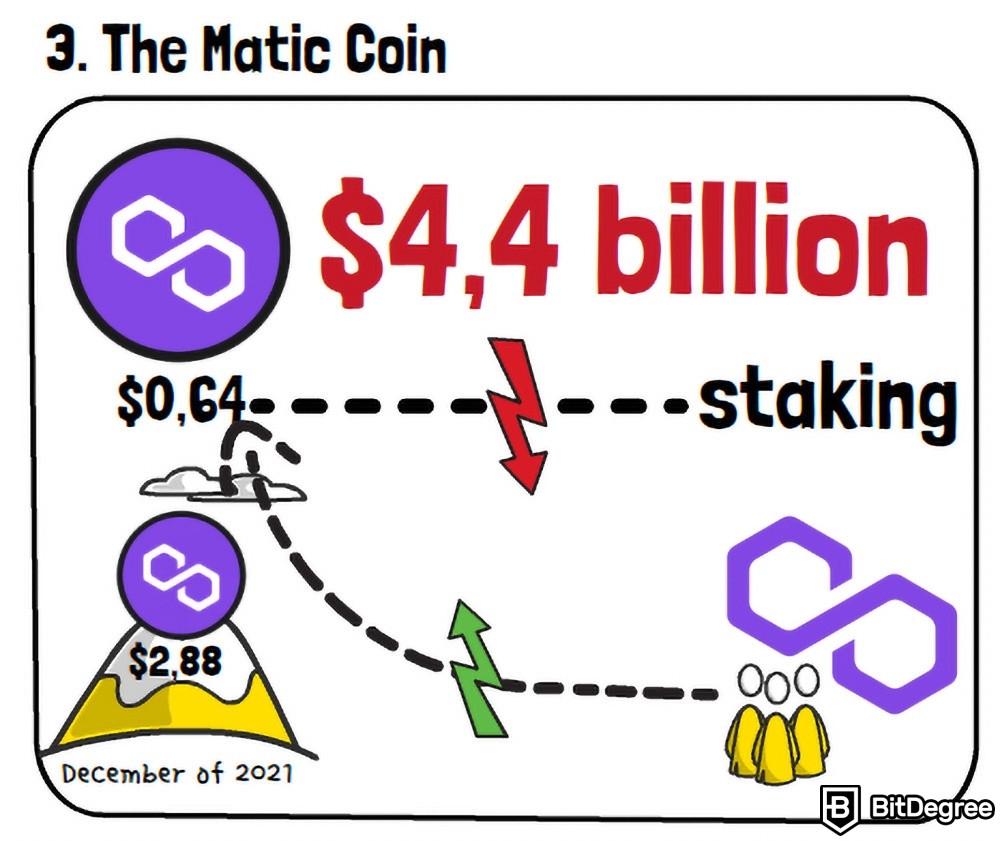2.12 Polygon: the Essential Scaling Solution for Ethereum
Stop overpaying - start transferring money with Ogvio. Sign up, invite friends & grab Rewards now! 🎁
In this section, I’m going to tell you what is Polygon in crypto!
Imagine that you’ve bought a new phone. After you start using it, you notice that, while it’s super-modern, and supports all of the latest apps, it has a lot of issues - the battery runs out very fast, everything’s slow to load, and the apps glitch out every once in a while.

You could change your phone, sure, but then you wouldn’t be able to use many of the most popular applications that all of your friends are using, since only this phone supports them! However, there’s an alternative - a third-party update that would allow your phone to resolve many of these issues. In essence, this is the relationship between Ethereum and Polygon.
In this section, I’m going to tell you all about Polygon. We’ll talk about what it is, how it works, and why it has become the essential tool for all Ethereum users.
Let’s get to it!

Video Explainer
Video Explainer: Polygon: the Essential Scaling Solution for Ethereum
Reading is not your thing? Watch the "Polygon: the Essential Scaling Solution for Ethereum" video explainer
What is Polygon in Crypto? (Animated Explainer)


What is Polygon?
To start off, before we can get into the topic of what is Polygon, you first need to understand Ethereum, and all of the main issues associated with this blockchain. Since this isn’t a section about Ethereum, I’ll be quick.
So, as of writing this section, Ethereum is the second-most popular crypto network, right after Bitcoin. It’s super popular for a variety of reasons - smart contracts, dApps, it being the center hub of DeFi, and so on. Having said that, though, this does not mean that ETH is issue-free - in fact, there are quite a few big issues associated with this blockchain!

First and foremost, Ethereum is a dated blockchain. There’s a variety of different networks that are much faster, easier to use, and that require far fewer resources in order to upkeep and maintain. Ethereum will soon launch its ETH 2.0 update, which will address many of these issues, but as of writing this section, it’s a blockchain that certainly lacks in certain areas!
Among the most notable of these areas is the “TPS” metric, also known as “transactions per second”. At present time, Ethereum is able to confirm around 30 transactions per second. As you can imagine, for a network as popular as this, a number like this is detrimental. This is especially true when you consider the fact that, say, Solana - a popular competing blockchain - can support over 65,000 TPS. The difference is crazy!
Since Ethereum can only support so few transactions per second, this leads the network to another huge issue - gas fees. These are the fees that you pay in order to perform a transaction on Ethereum - say, sending some ETH to your friend or relative, or buying the newest token that has hit the market.
Essentially, if you want your transaction to be confirmed in a speedy manner, you’ll need to pay higher fees than some other individual sending their ETH to their friends or relatives. These fees can become very irrational, fast!
On the user end of things, this is already super-inconvenient, and isn’t how the second-largest blockchain should look like! To add to that, Ethereum is also difficult to work with, if you’re a developer, and are creating a dApp on this blockchain.
Now, how does all of this tie into the question of what is Polygon? Well, the biggest thing that you should take away from this section is the fact that Polygon is a separate blockchain that utilizes Ethereum’s technology, with the goal to address and solve all of these issues that I’ve just mentioned.
Polygon was created all the way back in 2017, and from day one, its main goal was to tackle all of the shortcomings associated with ETH. Initially, Polygon was called Matic, but at some point, it rebranded to its current name - the native coin of the network, however, is still referred to as the Matic Coin.
How Does Polygon Work?
Continuing on with the section, I admit - it’s pretty simple to just say that Polygon aims to solve the issues that are present with the Ethereum blockchain, and leave it at that. However, it’s also important to tackle the question of HOW Polygon achieves this, in the first place!
Think about the example I gave at the beginning of the section. Ethereum would be that awesome new phone that you’ve bought - it’s full of issues, sure, but it’s still the most popular and widely-used phone, since it’s both established, and supports all of the most popular applications - something that no other phone is able to claim.

Polygon would be that aforementioned update to your phone. In the world of crypto, Polygon is referred to as a “Layer-2 scaling solution”. It’s a complex topic, but essentially, the way you can look at it is this - Polygon allows developers and end-users on the Ethereum blockchain to connect to its network and avoid many of the shortcomings associated with ETH.
So, to put it in other words, imagine that you want to purchase a computer game, for cryptocurrencies. The game is based on the Ethereum blockchain, and costs a crazy amount of ETH to buy - the price itself isn’t all that big, but the transaction fees are double that of the price! Well, what if you could purchase that same game for Matic coins, pay very small transaction fees, and then still play the game with all of the benefits that are available on the Ethereum blockchain?
Sounds awesome, right? Well, put simply, this is possible, and it’s one of the core features of Polygon! That’s because of how similar Polygon is to Ethereum, blockchain development-wise. Some places around the internet use the term “EVM” to describe the way that Polygon works. This term abbreviates as “Ethereum Virtual Machine”, and it essentially describes the ecosystem that is powered by Ethereum’s code, but is based on a third-party blockchain.

Why is EVM functionality important? Well, it allows different projects to migrate between blockchains, in an almost seamless manner. For example, developers of the earlier-mentioned game could take it from the Ethereum blockchain, and transfer it to Polygon, and it would essentially work in the exact same manner. Just with all of the added benefits of Polygon - small gas fees, super-quick transactions, and so on. In this sense, Polygon is helping Ethereum to scale!
This is actually one of the core goals of Polygon, too! Since it’s a Layer-2 blockchain, it aims to help Ethereum manage all of the transactions that it deals with, and by doing so, help scale the main network, indefinitely.
To help you better understand how this works, you can think about it in a visual manner - imagine the Ethereum blockchain as the main, huge network where a large variety of important processes happen every second. Since the network is so huge, it gets congested, and all of the issues that we’ve talked about earlier start to arise.
So, a much smaller network called Polygon enters the scene. It communicates with Ethereum, and says: "Hey! Redirect all of that huge amount of data to me, I’ll condense it to some much smaller units of information, and send it back to you!"
By utilizing its Proof-of-Stake consensus mechanism, Polygon is able to do just that, and in this way, it alleviates the load that the Ethereum mainnet receives. This is why Polygon is called a Layer-2 scaling solution - it’s literally a smaller network that works alongside Ethereum, with the goal to help this large network manage its processes!
It needs to be mentioned, though, that Polygon is a much larger project than just a “Layer-2 scaling solution for Ethereum”. While this is its main functionality that we - the everyday users - see, Polygon allows developers to work on complex, Ethereum-based projects in an approachable, multi-chain-oriented manner. It’s an entirely different field, and I won’t get into it here, since it would require a separate section in and of its own. Just keep in mind that Polygon is a much larger project than it might seem, initially!
The Matic Coin
Before I let you go, the one last thing that I want to tell you about in this section is the Matic coin. I mentioned it earlier - it’s the native cryptocurrency of the Polygon blockchain. However, what is it used for?
Well, essentially, Matic is a utility token. It has staking functionality, which means that the coin can be staked in order to earn passive rewards, in the form of more Matic. If you’d like to learn more about staking, I have a section on that, too!
The second large purpose of the Matic coin is to incentivize developers and users on the Polygon blockchain to perform different processes on the network! It does tie in with staking, but if you provide your computational resources to Polygon, and are an active developer on the network, this can result in Matic rewards!
Lastly, the coin is used to pay for transaction fees, whenever you perform those transactions on the blockchain.

As of writing this section, Matic currently has a market cap of $4,4 billion and is worth around $0,64. At its highest point back in December of 2021, it was worth $2,88. The coin currently has inflationary mechanics, due to the staking functionality - however, the team behind Polygon aims to make the coin deflationary, at some point in time. This could theoretically help it increase in value, too!
Wrapping things up, whether you’re a developer or a crypto enthusiast, Polygon is definitely one of the more-interesting projects that are certainly worth checking out, especially if you’re fascinated with all-things Ethereum.










